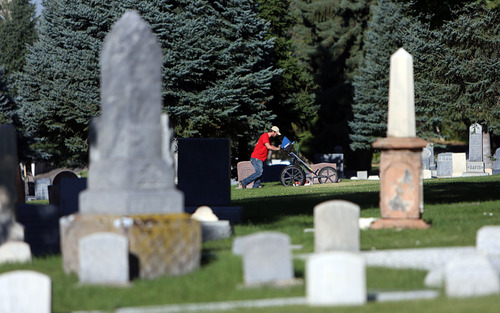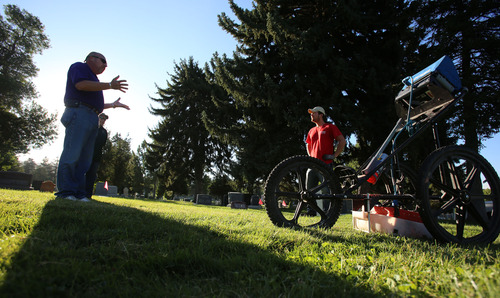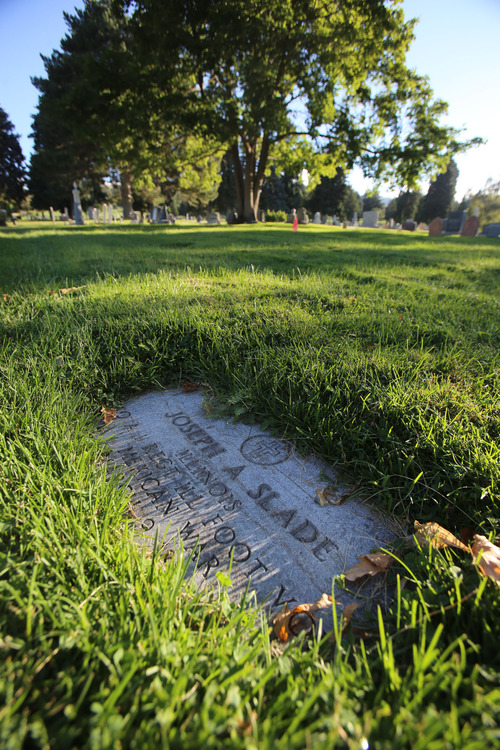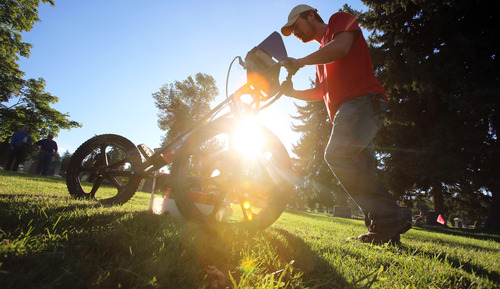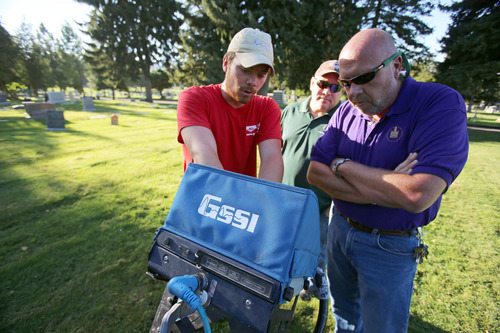This is an archived article that was published on sltrib.com in 2013, and information in the article may be outdated. It is provided only for personal research purposes and may not be reprinted.
Her husband had been cut down from the rope by the time Virginia Slade rode into town.
The body of Jack Slade, one of the West's most feared gunfighters, a man who had once been known as The Law West of Kearny, lay unceremoniously in a Montana hotel parlor. Nerve-racked escorts led Virginia to his side, where she wept and protested. He ought to have at least been shot. "No dog's death should have come to such a man."
—
That was March 10, 1864. Almost 150 years later, Slade lies somewhere in the dirt of Salt Lake City Cemetery's Plot B, Block 4. You can find his modest military gravestone in the middle of a pauper's field, looking from afar like a drain cover on any old stretch of grass. What you can't find, what nobody can find, as yet, is Jack Slade's body.
Wednesday morning saw Philadelphia-based writer and Slade buff Dan Rottenberg take a crack at doing just that, hoping to fulfill Virginia Slade's long-ago wish to have her husband's corpse transported to his hometown of Carlyle, Ill. A radar technician walked a 400 megahertz, ground-penetrating radar — mounted on a souped-up jogging stroller — north and south, east and west across the 30-by-60-yard field, searching intently for evidence of a lone metal-lined casket amid 500 or so cheap wood boxes.
Alas, Slade eluded them.
That seems largely due to the limitations of the radar's electromagnetic pulse, which can penetrate as deep as 10 feet in ideal conditions but bounces off Utah's hard clay at lesser depths. Every site is different, said Ground Penetrating Radar Services technician Adam Kubicki, but in this case that barrier was found between 3 and 4 feet — not reaching the standard 6-foot depth of graves dug before the use of concrete vaults in the 1960s. Thus, Kubicki found the sprinkler system, but in passing by a body that was marked in 1891, he saw nothing.
Kubicki was understandably frustrated — "I told my girlfriend the other day, 'I'm going to go search for this famous cowboy, and I just don't want to disappoint' " — but Salt Lake City Sexton Mark Smith saw a bright side to not finding Slade: "He's a fun guy to have around."
Rottenberg, who wrote what he hopes is the definitive book on Slade, "Death of a Gunfighter," told The Salt Lake Tribune by phone that he was saddened by the news. If the author can locate the body, he intends to get a court order to have it exhumed and moved. But that's going to have to wait. "This was a man who was very hard to pin down in life," Rottenberg said, "and apparently he's very hard to pin down in death."
As superintendent of Central Overland's Sweetwater Division, Slade nourished an outsized reputation as a deadly shot and a zealous law enforcer who was responsible for 26 killings. In truth, Rottenberg says, Slade was only proven to have killed one man, but he relied on the power of tall tales to keep criminals at bay along the treacherous stage coach routes from Fort Kearny, Neb., to Salt Lake City.
Rottenberg credits Slade with helping to launch the Pony Express, restoring the peace in a perilous region and delivering the West's great riches to the Union ahead of the coming Civil War. But for all his uncommon exploits, Slade had a common failing. He was fired for drunkenness and spent his final days as a regular bully in the Montana mining town of Virginia City. A particularly lurid spree prompted a local commission of vigilante settlers to lynch him.
Virginia Slade refused to have her husband buried where he would not be remembered kindly, so she had his coffin lined with tin and zinc to prevent leaks and filled it with whiskey — the best preservative available at the time. The coffin sat in the front room of her small house in town for three months until the road thawed and, in June, she had the coffin loaded onto a stage to Salt Lake City. There he was interred, somewhere in Block 4, "to be removed to Illinois in the fall," according to the city's then-sexton.
"Life sort of overwhelmed" Virginia, Rottenberg said. She was married twice more and wound up in St. Louis, just 50 miles from Carlyle, but she either never tried or was never able to have her husband dug up and reburied there.
Rottenberg's obsession with Slade began as a child when he read about the Pony Express. He thought Slade had gotten a bad rap. "He was maintaining order pretty much single-handedly," Rottenberg said. "The way he did it was by spreading rumors that he was a vicious killer, and he really wasn't."
Finding the body could restore Slade's good name, he believes, but is it worth it? He spent $750 to hire GPRS for Wednesday's search. Kubicki believes a 270 megahertz antenna might still locate Slade (the lower the megahertz, the more powerful), but it would have to be shipped in. Rottenberg didn't say if he'd pay for the stronger radar, but he did tell a story about Slade that was in his thoughts.
According to S.L. Hubbell, a fellow eastbound traveler, Slade left Salt Lake City with the mail in mid-February 1859, during a snowstorm. When Hubbell joined up with Slade's party, they had trekked 2 miles in 11 hours, with no sleep. The travelers consulted. Some favored turning back. "But Agent Slade said, 'Go ahead,' " Hubbell wrote. The next half mile, up a mountain, took eight hours. Downhill was worse, as snow reached depths of 20 feet and the party members — mostly blinded by the snow — had to drag their mules.
When they finally reached the next station, they had covered 47 miles in 11 days. And while they could have waited out the storm and made up that ground in double time, Jack Slade wasn't one to yield to hardships.
Finding his body "sounds like a long shot," Rottenberg said. But "my basic philosophy has been that however challenging or difficult this project may be, it's small potatoes compared to what Jack Slade went through."
Twitter: @matthew_piper


